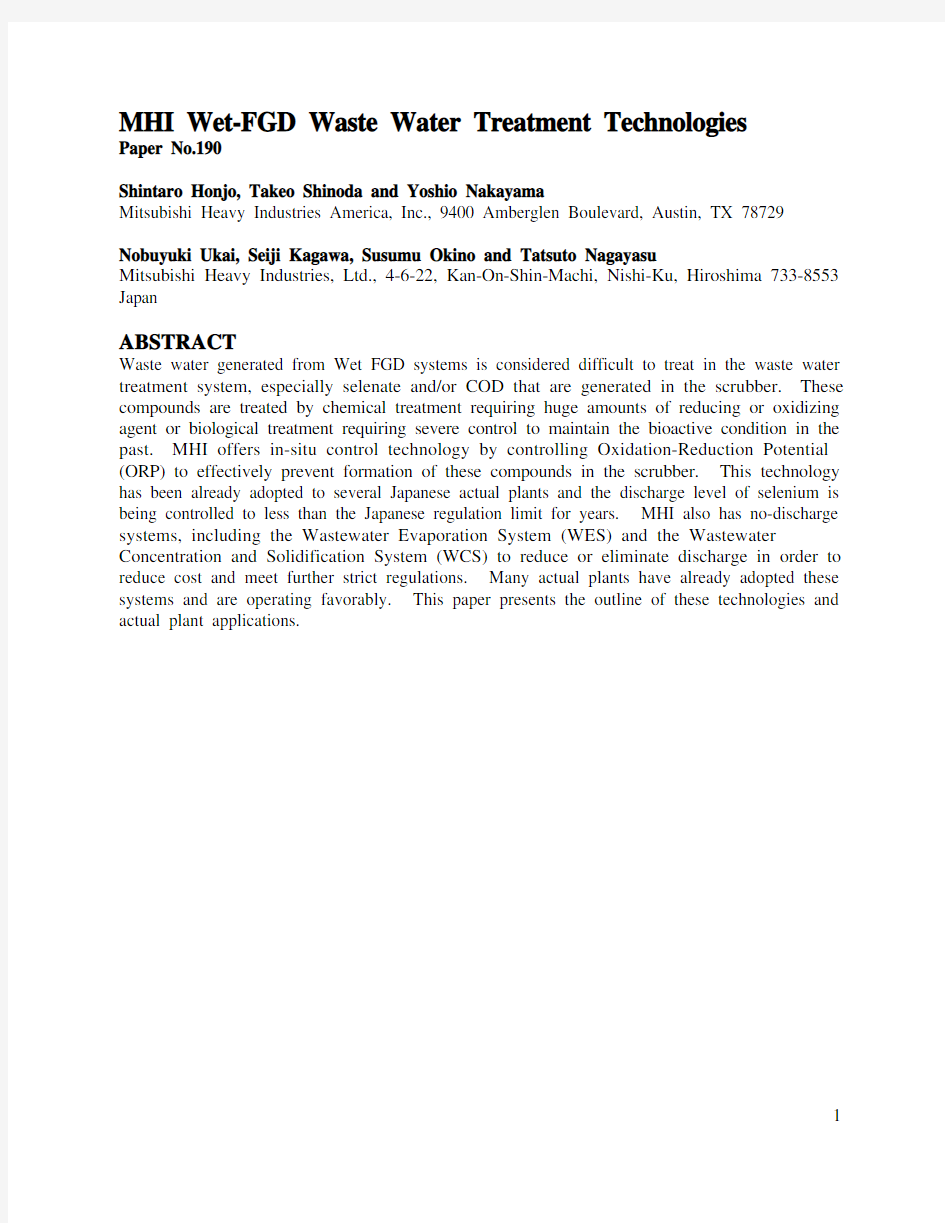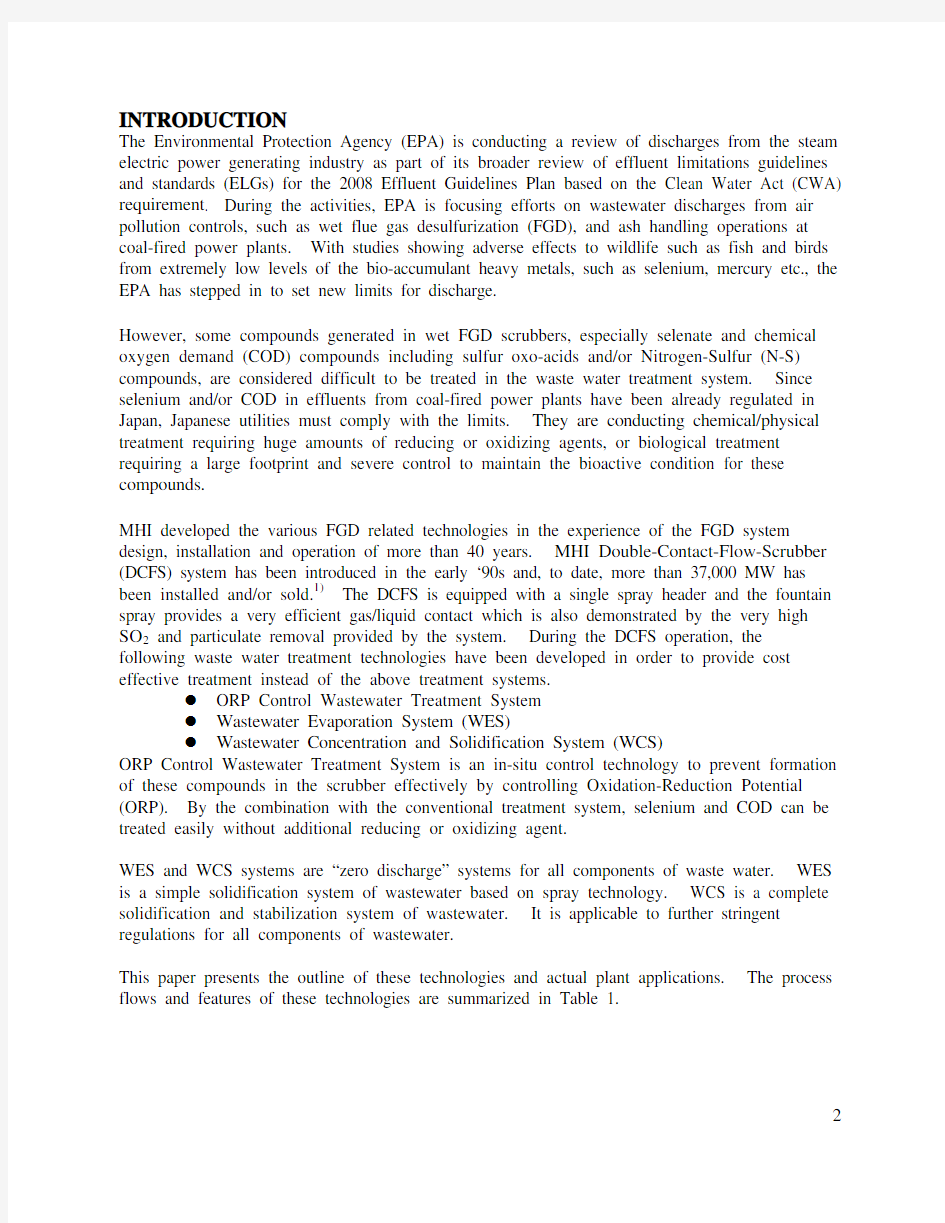

MHI Wet-FGD Waste Water Treatment Technologies
Paper No.190
Shintaro Honjo, Takeo Shinoda and Yoshio Nakayama
Mitsubishi Heavy Industries America, Inc., 9400 Amberglen Boulevard, Austin, TX 78729 Nobuyuki Ukai, Seiji Kagawa, Susumu Okino and Tatsuto Nagayasu
Mitsubishi Heavy Industries, Ltd., 4-6-22, Kan-On-Shin-Machi, Nishi-Ku, Hiroshima 733-8553 Japan
ABSTRACT
Waste water generated from Wet FGD systems is considered difficult to treat in the waste water treatment system, especially selenate and/or COD that are generated in the scrubber. These compounds are treated by chemical treatment requiring huge amounts of reducing or oxidizing agent or biological treatment requiring severe control to maintain the bioactive condition in the past. MHI offers in-situ control technology by controlling Oxidation-Reduction Potential (ORP) to effectively prevent formation of these compounds in the scrubber. This technology has been already adopted to several Japanese actual plants and the discharge level of selenium is being controlled to less than the Japanese regulation limit for years. MHI also has no-discharge systems, including the Wastewater Evaporation System (WES) and the Wastewater Concentration and Solidification System (WCS) to reduce or eliminate discharge in order to reduce cost and meet further strict regulations. Many actual plants have already adopted these systems and are operating favorably. This paper presents the outline of these technologies and actual plant applications.
INTRODUCTION
The Environmental Protection Agency (EPA) is conducting a review of discharges from the steam electric power generating industry as part of its broader review of effluent limitations guidelines and standards (ELGs) for the 2008 Effluent Guidelines Plan based on the Clean Water Act (CWA) requirement. During the activities, EPA is focusing efforts on wastewater discharges from air pollution controls, such as wet flue gas desulfurization (FGD), and ash handling operations at coal-fired power plants. With studies showing adverse effects to wildlife such as fish and birds from extremely low levels of the bio-accumulant heavy metals, such as selenium, mercury etc., the EPA has stepped in to set new limits for discharge.
However, some compounds generated in wet FGD scrubbers, especially selenate and chemical oxygen demand (COD) compounds including sulfur oxo-acids and/or Nitrogen-Sulfur (N-S) compounds, are considered difficult to be treated in the waste water treatment system. Since selenium and/or COD in effluents from coal-fired power plants have been already regulated in Japan, Japanese utilities must comply with the limits. They are conducting chemical/physical treatment requiring huge amounts of reducing or oxidizing agents, or biological treatment requiring a large footprint and severe control to maintain the bioactive condition for these compounds.
MHI developed the various FGD related technologies in the experience of the FGD system design, installation and operation of more than 40 years. MHI Double-Contact-Flow-Scrubber (DCFS) system has been introduced in the early ‘90s and, to date, more than 37,000 MW has been installed and/or sold.1)The DCFS is equipped with a single spray header and the fountain spray provides a very efficient gas/liquid contact which is also demonstrated by the very high SO2 and particulate removal provided by the system. During the DCFS operation, the following waste water treatment technologies have been developed in order to provide cost effective treatment instead of the above treatment systems.
z ORP Control Wastewater Treatment System
z Wastewater Evaporation System (WES)
z Wastewater Concentration and Solidification System (WCS)
ORP Control Wastewater Treatment System is an in-situ control technology to prevent formation of these compounds in the scrubber effectively by controlling Oxidation-Reduction Potential (ORP). By the combination with the conventional treatment system, selenium and COD can be treated easily without additional reducing or oxidizing agent.
WES and WCS systems are “zero discharge” systems for all components of waste water. WES is a simple solidification system of wastewater based on spray technology. WCS is a complete solidification and stabilization system of wastewater. It is applicable to further stringent regulations for all components of wastewater.
This paper presents the outline of these technologies and actual plant applications. The process flows and features of these technologies are summarized in Table 1.
THEORY
ORP Control Wastewater Treatment System
When selenium in coal is burned in the boiler of coal-fired power plant, a large part of selenium in the flue gas can be captured by particulate collectors. Some part of selenium can be captured by a FGD scrubber and be discharged from the scrubber as effluent. In some cases, selenium concentration in the effluent exceeds the limit of Japanese regulations depending on the content of coal, and selenate (SeO42-). Although selenite (SeO32-) has been treated easily by
co-precipitate and/or adsorption treatment in general, since selenate is hard to precipitate and cannot be treated effectively in the process, a special treatment system for selenate, such as biological treatment, is required to comply with the limit.
In addition, dithionate (S2O62-) and/or peroxydisulfate (S2O82-) would be formed in the scrubber by adding excess oxidation air. S2O62- would be a COD source and not easily treatable.
S2O82- would degrade adsorption resins used for COD treatment. Both compounds would be required to be treated or prevented from forming in the application in Japan.
MHI developed and applied their patented technologies to control the formation of selenate, dithionate and peroxydisulfate by controlling ORP. Selenium enters the scrubber as elemental selenium and/or selenium dioxide (SeO2) and is captured by the scrubber. Captured selenium can be oxidized to selenate by excess oxidation air, producing gypsum. ORP is an indicator of oxidation state of the scrubber liquid and can be used to control oxidation air flow rate. It can reduce the formation of selenate by controlling the air flow rate based on the ORP signals of the scrubber liquid without any additives. The relationships of ORP and selenium speciation/sulfite (SO32-) concentration are shown in Figure 1. Increasing oxidation air and ORP, sulfite (shown
as SO3) would be lowered and selenate (shown as Se (VI)) would be increased. Decreasing oxidation air and ORP, sulfite and selenite (shown as Se (IV)) would be increased. Since it is necessary to control sulfite concentrations lower than design values in order to maintain the SO2 removal performance of FGD scrubbers in the limestone forced oxidation process, it is required to control ORP within the optimum range to prevent formation of both sulfite and selenate. ORP control systems can provide the control technology for selenium while maintaining FGD performance.
higher
Figure
At the same time, the formation of dithionate and peroxydisulfate in the scrubber is also controlled by controlling ORP within the optimum ORP range. Fortunately, preferable ORP ranges for prevention from formation of dithionate and peroxydisulfate are similar to selenium control.
The process flow of the ORP Wastewater Treatment System is shown in Figure 2. This system consists of the following processes.
9ORP control process:
Oxidation state of selenium in the FGD scrubber is controlled to selenite by the ORP control system in order to prevent formation of selenate, which is hard to precipitate.
The formation of dithionate and peroxydisulfate in the scrubber is also controlled.
9Sedimentation process:
Selenite in waste water from FGD is treated by co-precipitation with reagent. Treated selenite is recovered as sludge.
Treated
water Figure 2 Process Flow of ORP Control Wastewater Treatment System
Waste Water Evaporation System (WES)
The Wastewater Evaporation System is a simple “zero discharge” technology. WES has a lot of cost-effective features, including:
9No Liquid Discharge from FGD
9Nonoccurrence of Secondary Environmental Pollution
9Low Investment / Operation Cost
9Small Space Requirement
9Low Utility Consumption
9Evaporate Waste Water by Hot Flue Gas (No additional heat)
9Residual Solids Captured by ESP (No discharge of additional sludge)
After separation of gypsum, the waste water from wet-FGD scrubbing is sprayed in the ductwork upstream of particulate control devices, such as an electrostatic precipitator (ESP) or fabric filter (FF). Sprayed waste water is vaporized in the ductwork by the heat of the flue gas stream and solidified as particulates. Solidified particulates are collected across particulate control devices (PCD). Liquid discharge is eliminated from the FGD system. System flow of the WES is shown in Figure 3.
Gypsum
Figure 3 System Flow of Wastewater Evaporation System
High-efficiency twin-fluid spray nozzles are adopted in the system to control the size and vaporization rate of sprayed waste water droplets in order to avoid ash build-up on the bottom of the ductwork, collision of unvaporized droplets with the sidewall of the ductwork and promote entrainment of wetted particulates to the PCD. Pressurized atomizing air is mixed with waste water in the twin-fluid nozzle and makes fine droplets. Required residence time for evaporation could be very short time depending on the flue gas temperature and spray flow rate. The outline of the WES spray is shown in Figure 4. Photos of the Wastewater Spray Nozzles for the WES system are shown in Figure 5.
Figure 4 Outline of WES spray
Figure 5 Wastewater Spray Nozzles for WES system
Wastewater Concentration and Solidification System (WCS)
The WCS is a complete solidification and stabilization system of wastewater 2). Features of the WCS are as follows:
9 No Liquid Discharge from FGD
9 Generation of Harmless Solidified Substance (Reduced Environmental Burdens) 9 Simple Process (Concentration & Solidification Process) 9 Reduced Operation Cost 9 Reduced Installation Space
Waste water from the FGD plant is concentrated and reduced in volume through evaporation. Then it is mixed and kneaded with fly ash and cement to form a stable solidified substance. The system flow diagram of WCS is shown in Figure 6.
Concentration of FGD waste water
by using steam
Solidification by mixing concentrated
liquid with fly ash and cement
Solidification Process
Concentration Process
PLANT OPERATION RESULTS
ORP Control Wastewater Treatment System
ORP Control Wastewater Treatment System has been adopted to several plants having installed MHI FGD systems in Japan. The target effluent limit 3) of regulated compounds including selenium (0.1mg/L) has been achieved in these plants for years since installing the ORP Control system.
Waste Water Evaporation System (WES)
WES has been already installed in 10 plants. Delivery records of WES systems are shown in Table 2. These systems are operating normally.
Waste Water Concentration and Solidification System (WCS)
WCS has been already been installed in an actual plant where MHI provided the FGD system. It is operating favorably and producing a stable solidified substance. The solidified substance produced from the WCS process would be regulated as an industrial waste and has to comply with the regulatory limitations. The obtained solidified substance has passed the standards of solubility and strength4) provided. A photo of the solidified substance is shown in Figure 7.
Figure 7 Solidified substance
SUMMARY
MHI offers in-situ control technology by controlling Oxidation-Reduction Potential (ORP) to effectively prevent formation of selenate and/or COD compounds in the scrubber. This technology has been already adopted at several Japanese actual plants and the discharge level of selenium has been controlled to less than the Japanese regulation limit for years.
MHI also has no-discharge systems, including the Wastewater Evaporation System (WES) and the Wastewater Concentration and Solidification System (WCS) to reduce or eliminate discharge in order to reduce cost. Many plants have already adopted these systems and are operating favorably.
REFERENCES
1.Klingspor, S.J.; Okazoe, K.; Ushiku, T.; Munson, G.; paper presented at the EPRI-DOE-EPA
Combined Air Pollution Control Symposium: The Mega Symposium, May 19-22, 2003, Washington, DC.
2.Mitsubishi Heavy Industries, Ltd. Technical Review V ol.31 No.1 (Feb.1994)
3.Ministry of Environment, Government of Japan, National Effluent Standards, see
http://www.env.go.jp/en/water/wq/nes.html (accessed 2009)
4.Ministry of Environment, Government of Japan, Standards for Verification (hazardous
substances containing wastes), see http://www.env.go.jp/en/recycle/manage/sv.html (accessed 2009)
KEY WORDS
Coal combustion, Flue gas desulfurization, ORP control, Waste water treatment, selenium, COD, Waste water evaporation system, Waste water concentration and solidification system